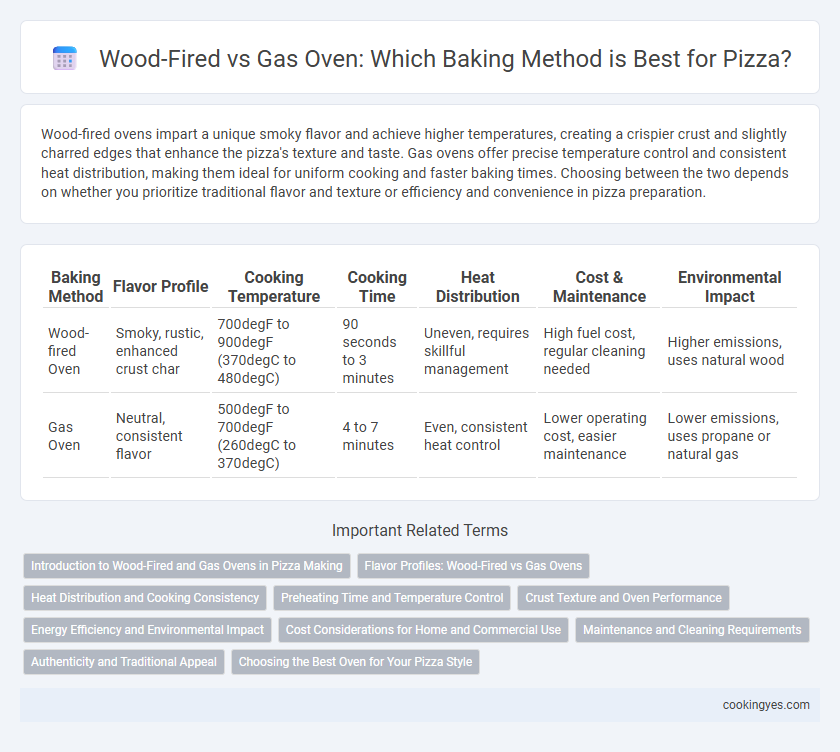Wood-fired ovens impart a unique smoky flavor and achieve higher temperatures, creating a crispier crust and slightly charred edges that enhance the pizza's texture and taste. Gas ovens offer precise temperature control and consistent heat distribution, making them ideal for uniform cooking and faster baking times. Choosing between the two depends on whether you prioritize traditional flavor and texture or efficiency and convenience in pizza preparation.
Table of Comparison
| Baking Method | Flavor Profile | Cooking Temperature | Cooking Time | Heat Distribution | Cost & Maintenance | Environmental Impact |
|---|---|---|---|---|---|---|
| Wood-fired Oven | Smoky, rustic, enhanced crust char | 700degF to 900degF (370degC to 480degC) | 90 seconds to 3 minutes | Uneven, requires skillful management | High fuel cost, regular cleaning needed | Higher emissions, uses natural wood |
| Gas Oven | Neutral, consistent flavor | 500degF to 700degF (260degC to 370degC) | 4 to 7 minutes | Even, consistent heat control | Lower operating cost, easier maintenance | Lower emissions, uses propane or natural gas |
Introduction to Wood-Fired and Gas Ovens in Pizza Making
Wood-fired ovens reach temperatures up to 900degF, creating a smoky flavor and crispy crust that defines traditional Neapolitan pizza. Gas ovens offer precise temperature control and consistency, making them ideal for high-volume pizza production with reliable results. The choice between wood-fired and gas ovens impacts flavor profiles, cooking times, and operational efficiency in pizza making.
Flavor Profiles: Wood-Fired vs Gas Ovens
Wood-fired ovens impart a distinct smoky, charred flavor to pizza, enhancing the crust's complexity and creating a unique rustic aroma. In contrast, gas ovens provide more consistent heat control, producing a cleaner, more neutral flavor that highlights the toppings without overshadowing them. Both methods influence the texture and taste, but wood-fired pizzas are renowned for their crispy, slightly blistered crusts and rich, aromatic profiles.
Heat Distribution and Cooking Consistency
Wood-fired ovens offer intense, radiant heat that creates a crispy crust and smoky flavor, but their heat distribution can be uneven, demanding constant attention for consistent results. Gas ovens provide steady and controlled heat, ensuring uniform temperature and consistent cooking across the pizza surface. Selecting between these methods depends on balancing the traditional smoky taste of wood-fired ovens with the precise, reliable heat control of gas ovens.
Preheating Time and Temperature Control
Wood-fired ovens typically require longer preheating times, often up to an hour, to reach temperatures between 700degF and 900degF, providing intense heat that creates a characteristic smoky flavor and crispy crust. Gas ovens offer shorter preheating periods, usually 15 to 30 minutes, with more precise temperature control ranging from 400degF to 600degF, allowing for consistent baking results. Temperature consistency in gas ovens reduces the risk of burning, while wood-fired ovens demand skillful heat management to maintain optimal cooking conditions.
Crust Texture and Oven Performance
Wood-fired ovens produce a distinctively crisp and blistered crust with complex smoky undertones, achieving high temperatures above 900degF that ensure rapid baking and ideal heat distribution. Gas ovens offer more consistent temperature control around 700-800degF, yielding a uniform crust texture with less charring and easier operation. The wood-fired oven's intense, uneven heat promotes a chewier, more artisan crust, while gas ovens provide reliability and efficiency suited for commercial pizza production.
Energy Efficiency and Environmental Impact
Wood-fired ovens typically consume more energy due to prolonged heating times and wood combustion, contributing higher CO2 and particulate emissions. Gas ovens provide more precise temperature control with better energy efficiency and lower emissions, reducing the overall environmental footprint. Choosing gas ovens supports sustainable practices by minimizing resource use and air pollution in pizza baking operations.
Cost Considerations for Home and Commercial Use
Wood-fired pizza ovens typically have higher initial costs and ongoing expenses related to fuel and maintenance, making them a more significant investment for both home and commercial use. Gas ovens offer lower upfront costs, easier temperature control, and reduced cleaning requirements, which can lead to cost savings in busy pizzerias and home kitchens. Evaluating fuel availability, energy efficiency, and operational expenses is crucial for determining the most cost-effective baking method for a specific setting.
Maintenance and Cleaning Requirements
Wood-fired ovens require regular removal of ash and creosote buildup to maintain optimal performance, demanding frequent cleaning and occasional chimney inspection. Gas ovens offer simpler maintenance with easy-to-clean surfaces and fewer residues, reducing downtime and labor costs. Proper upkeep of either oven ensures consistent pizza quality and extends equipment lifespan.
Authenticity and Traditional Appeal
Wood-fired ovens impart a distinct smoky flavor and charred crust that epitomizes authentic Neapolitan pizza, revered for its traditional appeal and artisanal quality. Gas ovens offer precise temperature control and consistent heat distribution, catering to efficiency without fully replicating the depth of flavor achieved by wood-fired baking. The choice between wood-fired and gas ovens ultimately hinges on prioritizing genuine traditional taste versus convenience and operational control.
Choosing the Best Oven for Your Pizza Style
Wood-fired ovens offer high temperatures and smoky flavor ideal for Neapolitan-style pizzas with thin, crispy crusts, while gas ovens provide consistent heat control suitable for thicker crusts and diverse toppings. The choice depends on your preferred pizza style and cooking environment, with wood-fired ovens excelling in traditional, charred finishes and gas ovens delivering convenience and uniform baking. Consider factors like heat retention, flavor infusion, and ease of use to select the oven that best complements your pizza recipes.
Wood-fired vs Gas oven for baking method Infographic

 cookingyes.com
cookingyes.com